Unsure about your French table manners? Click Here to download > > How to avoid these 10 food etiquette mistakes !
- Home ›
- Destinations ›
- Paris ›
- Underrated monuments in Paris
10 Fascinating Monuments In Paris Not Enough People Visit
Published 24 August 2025 by Leyla Alyanak — Parisian by birth, Lyonnaise by adoption, historian by passion
There is no shortage of headline monuments in Paris, but beyond the icons lie places with stories just as compelling. Here are a few lesser-known Paris landmarks that deserve far more attention than they get.
Paris doesn’t exactly lack monuments – you can probably recite the headline acts from memory: the Eiffel Tower, the Arc de Triomphe, Notre-Dame, the Louvre pyramid.
But hidden among the Paris monuments everyone knows are quieter memorials and statues that most people pass without a glance, often distracted by the view over the Seine or the boulevards.
Taken together, all these underrated monuments trace the city’s history from Roman gladiators to medieval dukes, from the Wars of Religion to the French Revolution, and from Enlightenment thinkers to the tragedies of the 20th century.
It's all there, and sometimes, all you have to do is look up (or down!).
With that in mind, here’s my pick of Paris monuments that deserve far more attention than they get.
NOTE: Pages on this site may contain affiliate links, which support this site. See full Privacy Policy here.
10 Paris monuments that don't receive the recognition they deserve
Of course this list is totally subjective, and we don't all love the same monuments. You might disagree with my choices – where I see something underrated, you might see it as overly popular.
With all its possible missteps, here is my list of Paris monuments I think deserve more fame.
♜ ♜ ♜ ♜
1. Arènes de Lutèce
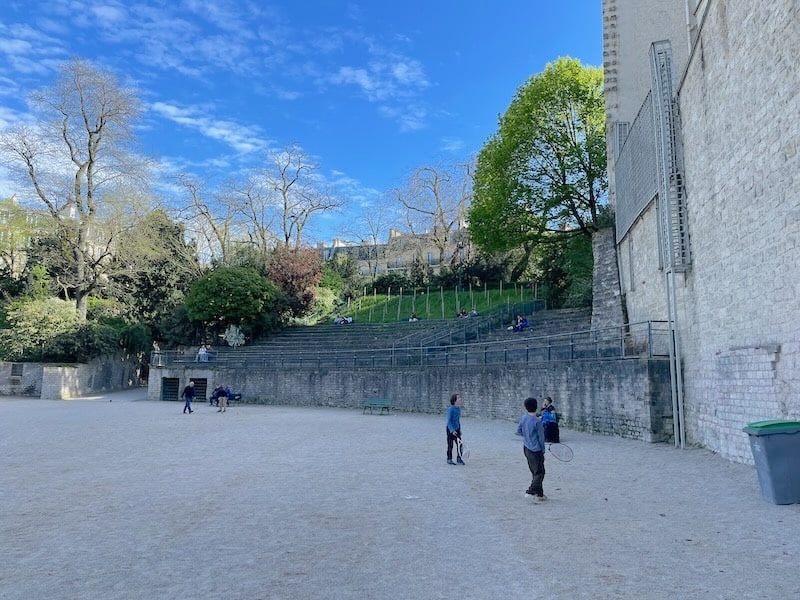 The Arènes de Lutèce, a 1st-century Roman amphitheater hidden behind Parisian apartment blocks ©OffbeatFrance
The Arènes de Lutèce, a 1st-century Roman amphitheater hidden behind Parisian apartment blocks ©OffbeatFranceYou could easily miss one of the last surviving Roman remains of Paris. The arena is hidden behind an ordinary residential building in the Latin Quarter, and you go in through what looks like a regular building entrance.
Once inside, you'll see kids kicking footballs and couples snuggling on the terraces, while bemused tourists look around for some evidence of Roman glory.
It was once here: built in the 1st century for gladiator fights and theatrical performances, the arena once held up to 17,000 people. It may not be intact, but it's still worth a visit if you love (as I do) visiting Roman ruins in France.
Location: 49 Rue Monge, 75005 Paris – Latin Quarter (5th arrondissement)
♜ ♜ ♜ ♜
2. Tour Jean-sans-Peur
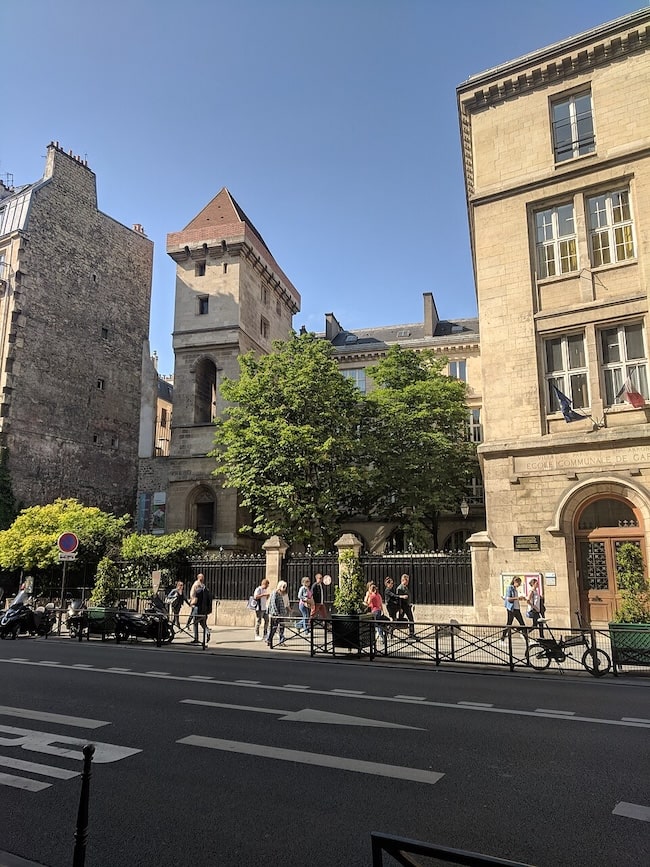 The Tour Jean-sans-Peur, a 15th-century tower hidden in the 2nd arrondissement — the last medieval stronghold in central Paris by jwalsh from Cambridge, CC BY 2.0
The Tour Jean-sans-Peur, a 15th-century tower hidden in the 2nd arrondissement — the last medieval stronghold in central Paris by jwalsh from Cambridge, CC BY 2.0In a quiet courtyard of the 2nd arrondissement stands the only surviving medieval tower in central Paris. It doesn't quite look as though it belongs in the heart of today's Paris...
Built in 1409 by John the Fearless, Duke of Burgundy, it was part of a fortified residence to protect him during the bloody feud between the Armagnacs and Burgundians.
Inside, you can climb the remarkable spiral staircase to admire the intricate designs of the vaulted ceilings. Like its Roman past, Paris isn't exactly full of relics of the Middle Ages so it's worth the detour.
And if you're a fan of the Middle Ages, don't miss the Cluny Museum, with its rich collections of the time.
Location: 20 Rue Étienne-Marcel, 75002 Paris (2nd arrt)
♜ ♜ ♜ ♜
3. Statue of Gaspard de Coligny
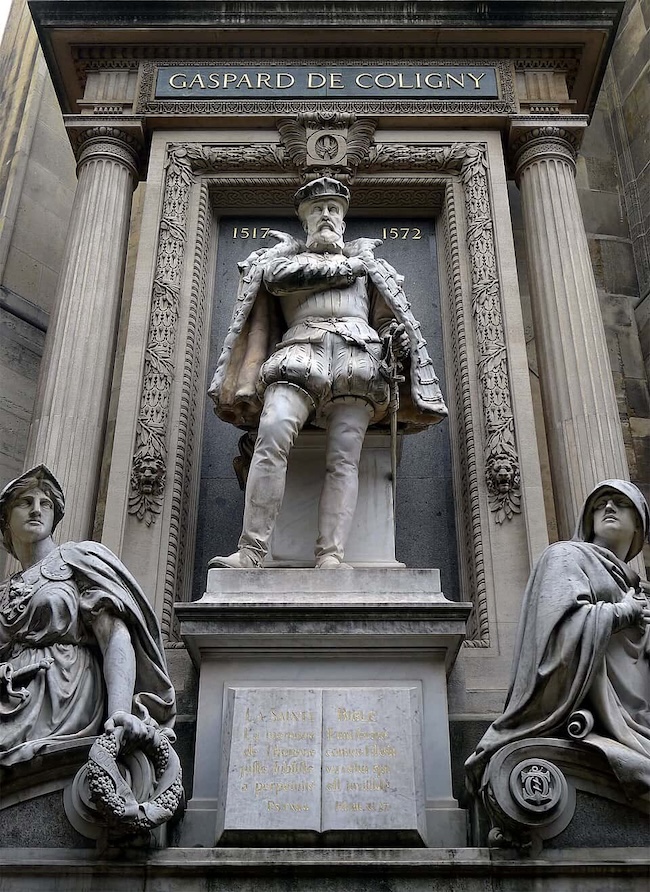 Coligny’s 1889 statue on the Oratoire du Louvre — a rare Protestant monument in a city that seldom commemorates its Wars of Religion. Photo by Mbzt, CC BY-SA 4.0
Coligny’s 1889 statue on the Oratoire du Louvre — a rare Protestant monument in a city that seldom commemorates its Wars of Religion. Photo by Mbzt, CC BY-SA 4.0The Wars of Religion, which lasted from 1562 to 1598, were devastating, culminating in the St. Bartholomew’s Day Massacre, when thousands of Protestants were killed in Paris.
A bronze statue of Admiral Gaspard de Coligny, leader of the Huguenots, stands against the façade of the Temple de l’Oratoire du Louvre church in remembrance of these events.
Erected in 1889, the statue is one of the very few Protestant monuments in the city, a reminder of a turbulent chapter of history that Paris has largely chosen to ignore.
Location: Temple de l’Oratoire du Louvre, 160 Rue Saint-Honoré, 75001 Paris (1st arrt)
♜ ♜ ♜ ♜
4. Chapelle expiatoire
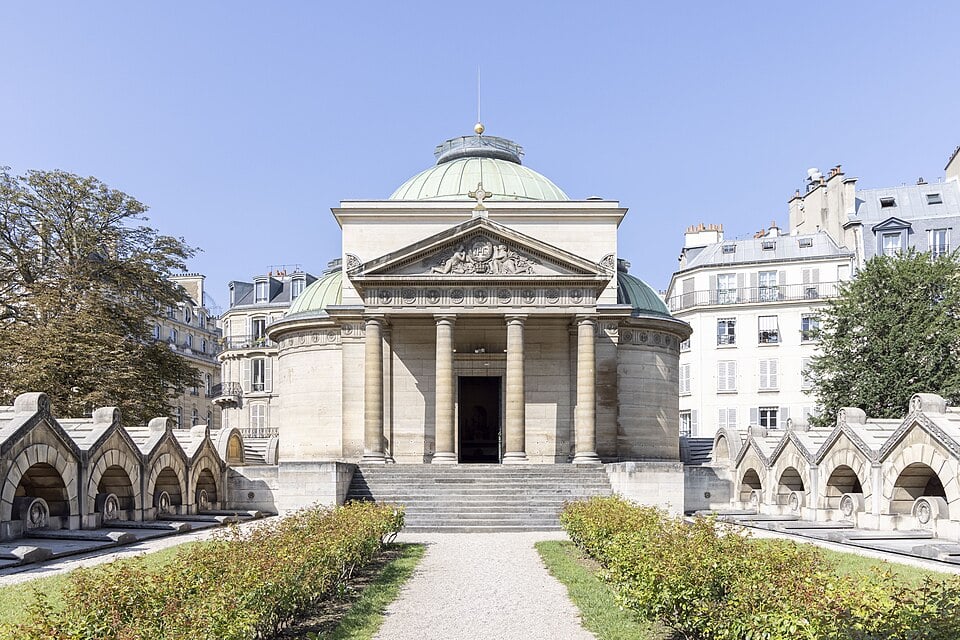 The sober front of the Expiatory Chapel hides sculptures and a Revolutionary necropolis inside. Photo by ZeusUpsistos, CC BY-SA 4.0
The sober front of the Expiatory Chapel hides sculptures and a Revolutionary necropolis inside. Photo by ZeusUpsistos, CC BY-SA 4.0The Expiatory Chapel was built on the site of the old Madeleine cemetery. This is where Louis XVI, Marie-Antoinette, and hundreds of others guillotined at what is now Place de la Concorde were first buried. Their remains were moved to Saint-Denis in 1815.
Louis XVIII commissioned architect Pierre Fontaine to build a chapel of remembrance for his brother and sister-in-law. Construction began in 1816 and was completed in 1826.
Inside, visitors are greeted by two neoclassical sculptures: The Apotheosis of Louis XVI by Bosio and Marie-Antoinette Supported by Religion by Cortot.
The lower chapel still has remains from the cemetery, which makes this both a memorial and a necropolis of the Revolution, and one of the few places where you can sense how French architecture was used for history as well as space.
Location: 29 Rue Pasquier, 75008 Paris (8th arrt)
♜ ♜ ♜ ♜
5. Statue of Denis Diderot
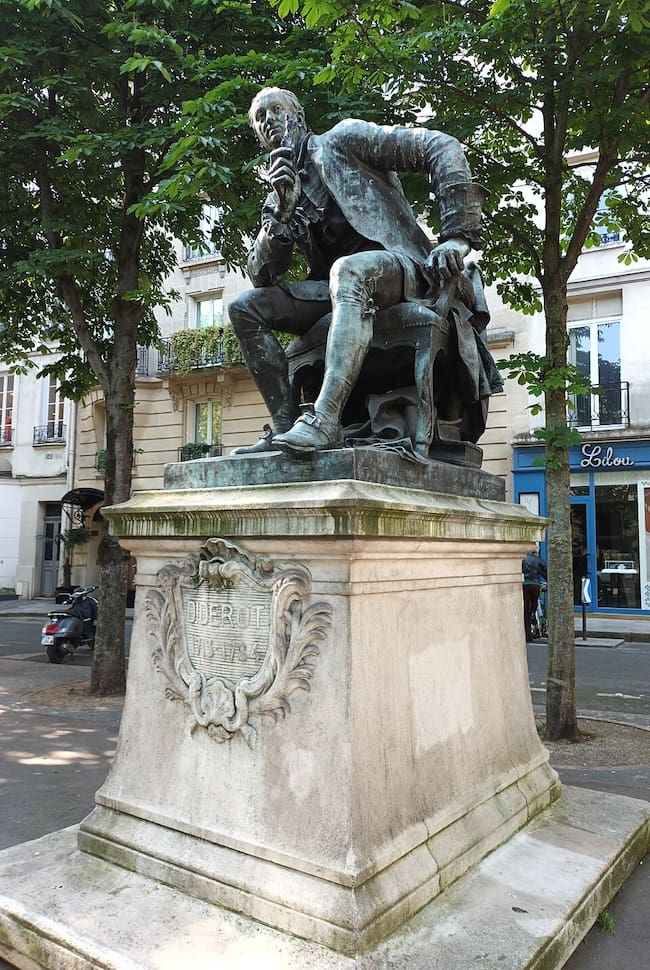 Diderot, co-founder of the Encyclopédie, sits unnoticed on Boulevard Saint-Germain despite his central role in the Enlightenment. Photo by Acediscovery, CC BY 4.0
Diderot, co-founder of the Encyclopédie, sits unnoticed on Boulevard Saint-Germain despite his central role in the Enlightenment. Photo by Acediscovery, CC BY 4.0The Boulevard Saint-Germain buzzes with activity so it's no wonder any statue here might go unnoticed.
Still, the bronze statue of Enlightenment philosopher Denis Diderot is worth a stop and a wonder.
He co-founded the Encyclopédie, a massive 28-volume book whose ambition upon publication in the 18th century was to capture and publish all human knowledge of the time. Diderot was also one of the thinkers who helped shape modern ideas of reason and progress.
Unveiled in 1886, the statue shows him seated pensively. Despite his importance, most passersby hurry past, unaware they’re in the presence of one of the Enlightenment’s greatest figures.
Location: Boulevard Saint-Germain, near Rue de l’Odéon, 75006 Paris (6th arrt)
♜ ♜ ♜ ♜
6. Monument to Pasteur
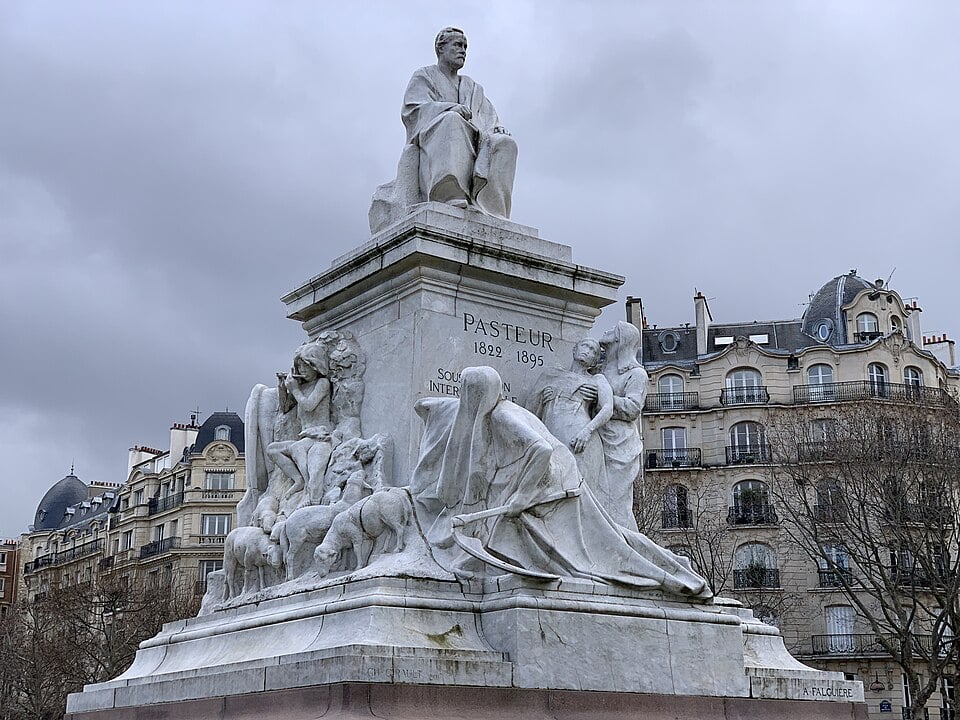 The Art Nouveau monument to Louis Pasteur at Place de Breteuil, unveiled in 1904 with allegories of Science and Public Health. Photo by Chabe01, CC BY-SA 4.0
The Art Nouveau monument to Louis Pasteur at Place de Breteuil, unveiled in 1904 with allegories of Science and Public Health. Photo by Chabe01, CC BY-SA 4.0A large monument to Louis Pasteur stands at the center of Place de Breteuil. It was inaugurated in 1904, nine years after his death.
Pasteur is shown seated in a chair, surrounded by bronze figures of scientists and patients that recall his breakthroughs in medicine, while the pedestal includes scenes of his research, such as his work on rabies and anthrax.
Although the monument dominates the square, the busy traffic circle around it means few people ever stop to look closely.
Location: Place de Breteuil, 75015 Paris (15th arrt)
♜ ♜ ♜ ♜
7. Mémorial de la Shoah
As you wander the Marais, tucked away in a quiet side street is the national centre of remembrance for the Holocaust in France, a museum and memorial.
It includes the Wall of Names, which lists more than 76,000 French Jews deported to concentration camps during World War II.
But it's not on the usual tourist route, so you'll have to make an extra effort to visit.
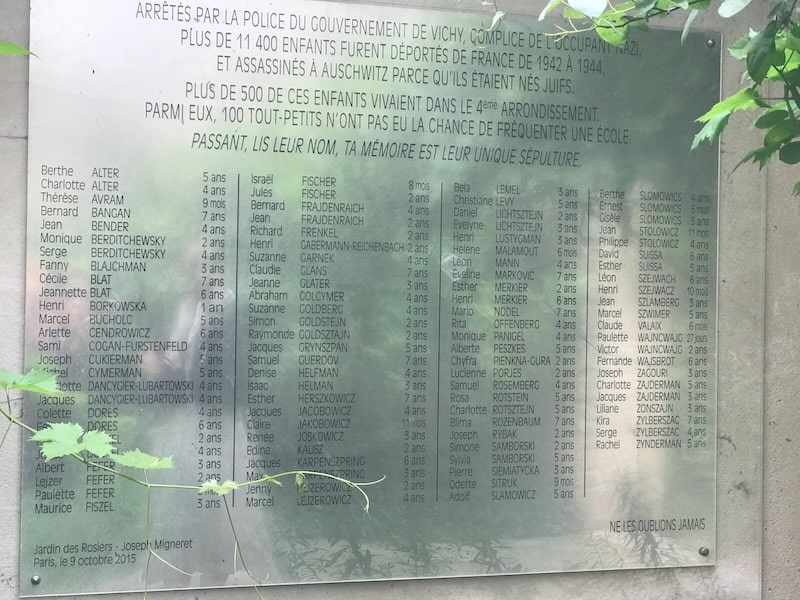 Inside the Jardin des Rosiers–Joseph-Migneret, a discreet plaque honors the memory of 11,400 Jewish children deported from France during World War II ©OffbeatFrance
Inside the Jardin des Rosiers–Joseph-Migneret, a discreet plaque honors the memory of 11,400 Jewish children deported from France during World War II ©OffbeatFranceA short ten-minute walk away is the Jardin des Rosiers, equally discreet, with a plaque commemorating the 11,400 Jewish children deported and killed in Auschwitz.
Location: 17 Rue Geoffroy l’Asnier, 75004 Paris – Marais (4th arrt)
♜ ♜ ♜ ♜
8. Monument des Martyrs de la Déportation
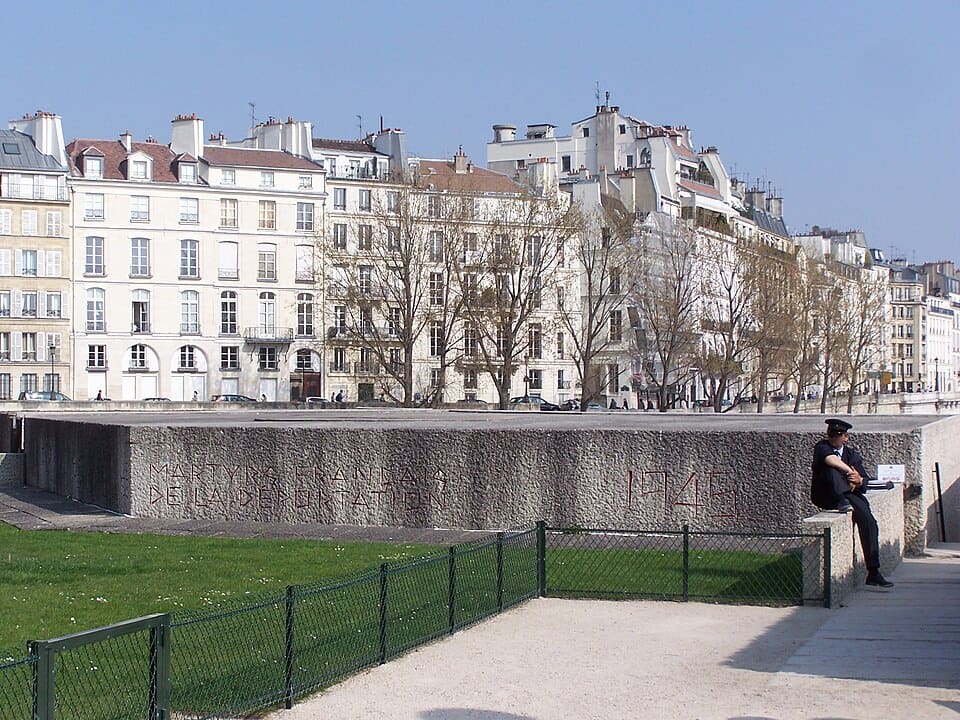 From the outside, the Memorial of the Martyrs of the Deportation resembles a plain concrete bunker – easy to miss behind Notre-Dame. Photo by LPLT, CC BY-SA 3.0
From the outside, the Memorial of the Martyrs of the Deportation resembles a plain concrete bunker – easy to miss behind Notre-Dame. Photo by LPLT, CC BY-SA 3.0It would surprise no one if you'd walked right past this concrete slab on your way to or from Notre-Dame. But head down the stairs and you'll find yourself in a very touching monument, one which honors the 200,000 people deported from France to Nazi concentration camps.
Inside, it's stark, not showy, except for the striking 200,000 glass crystals meant to symbolize each life lost. Otherwise, the memorial is designed to inflict a sense of loss and imprisonment, a tiny flicker of what deportees might have felt upon embarking on their fatal journey.
Location: Square de l’Île-de-France, 75004 Paris – Île de la Cité / behind Notre-Dame
♜ ♜ ♜ ♜
9. Flamme de la Liberté
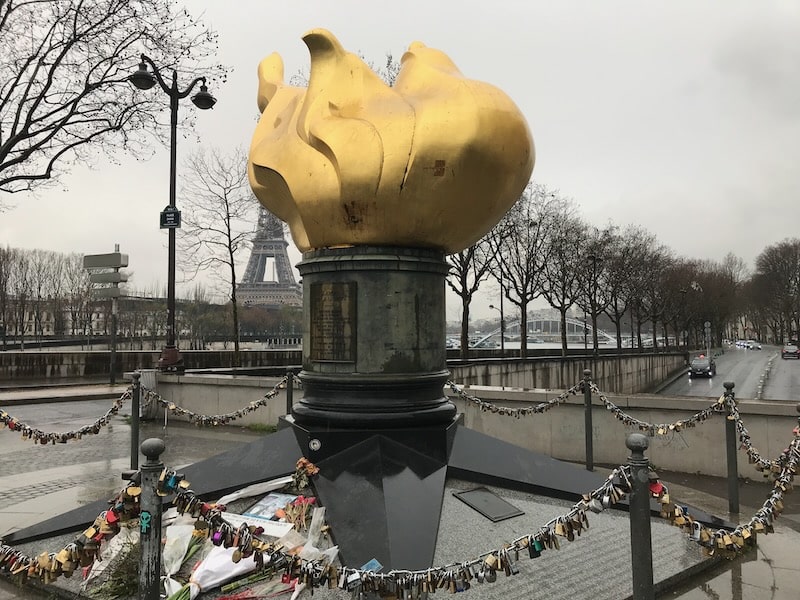 A perfect bronze twin of the Statue of Liberty’s torch, the Flame of Liberty, is one of Paris’s most photographed but least understood monuments ©OffbeatFrance
A perfect bronze twin of the Statue of Liberty’s torch, the Flame of Liberty, is one of Paris’s most photographed but least understood monuments ©OffbeatFranceIf you visit the Paris Sewer Museum, there's every chance you'll end up walking past this full-size replica of the torch from the Statue of Liberty.
It's above the entrance to the tunnel under the Pont de l’Alma and was originally placed here as a symbol of Franco-American friendship.
But after Princess Diana died in the tunnel below in 1997, it became her unofficial memorial – and a lot of people think that is what it actually is.
Location: Place de l’Alma, 75008 Paris – near Pont de l’Alma (8th arrt)
♜ ♜ ♜ ♜
10. Statue of Sainte Geneviève
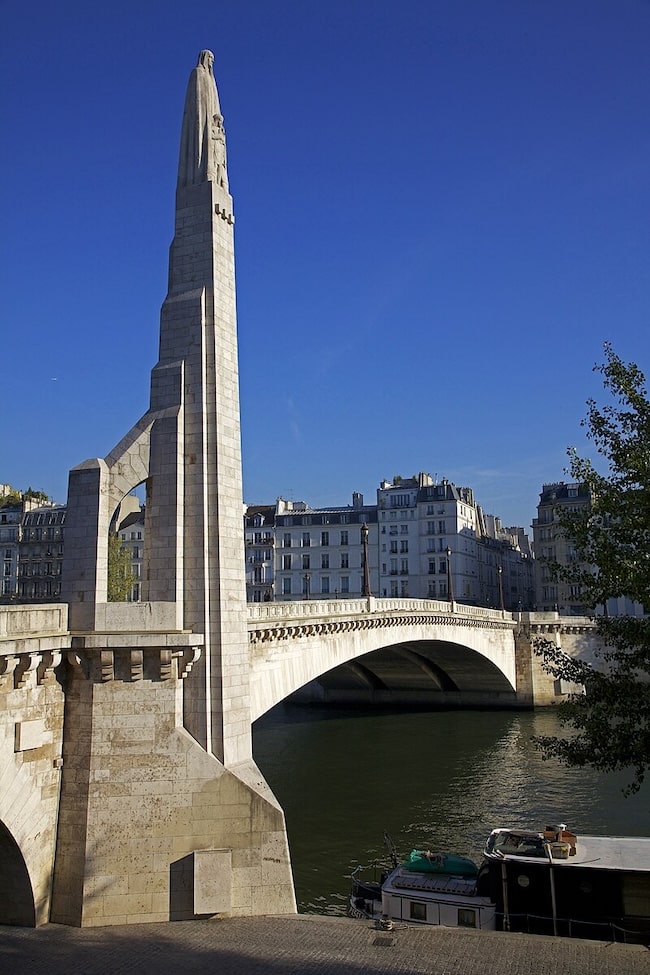 The 12 or 17-meter-high (depending on your source) statue of Sainte Geneviève at the end of the Pont de la Tournelle was created in 1928 by French sculptor Paul Landowski, who also designed Rio de Janeiro’s Christ the Redeemer. Photo by Jean-Marie Hullot from France, CC BY-SA 2.0
The 12 or 17-meter-high (depending on your source) statue of Sainte Geneviève at the end of the Pont de la Tournelle was created in 1928 by French sculptor Paul Landowski, who also designed Rio de Janeiro’s Christ the Redeemer. Photo by Jean-Marie Hullot from France, CC BY-SA 2.0It's difficult to miss the giant statue of Sainte Geneviève at the eastern end of the Pont de la Tournelle, but people do, focused as they are on the view of Notre Dame Cathedral and the wider world beyond.
Created in 1928 by French sculptor Paul Landowski – the same artist who designed Christ the Redeemer in Rio de Janeiro – the figure shows the young shepherd girl who, according to tradition, rallied Parisians to prayer and fasting in 451 CE, saving the city from Attila the Hun’s army.
For me, though, it carries special meaning: Sainte Geneviève was my mother’s patron saint, as she has long been Paris’s.
Location: Pont de la Tournelle, 75005 Paris (5th arrt)
Before you go...
So yes, you'll find plenty of more famous monuments and landmarks across Paris, hundreds of them.
These quieter monuments may not make the guidebook covers, but they each tell stories of Paris, a bit of hidden history, hiding in plain sight. And if you’d like more stories of quiet places in a noisy city, you might enjoy my piece on Paris’s less crowded and more unusual museums...
Did you enjoy this article? I'd love if you shared it!

